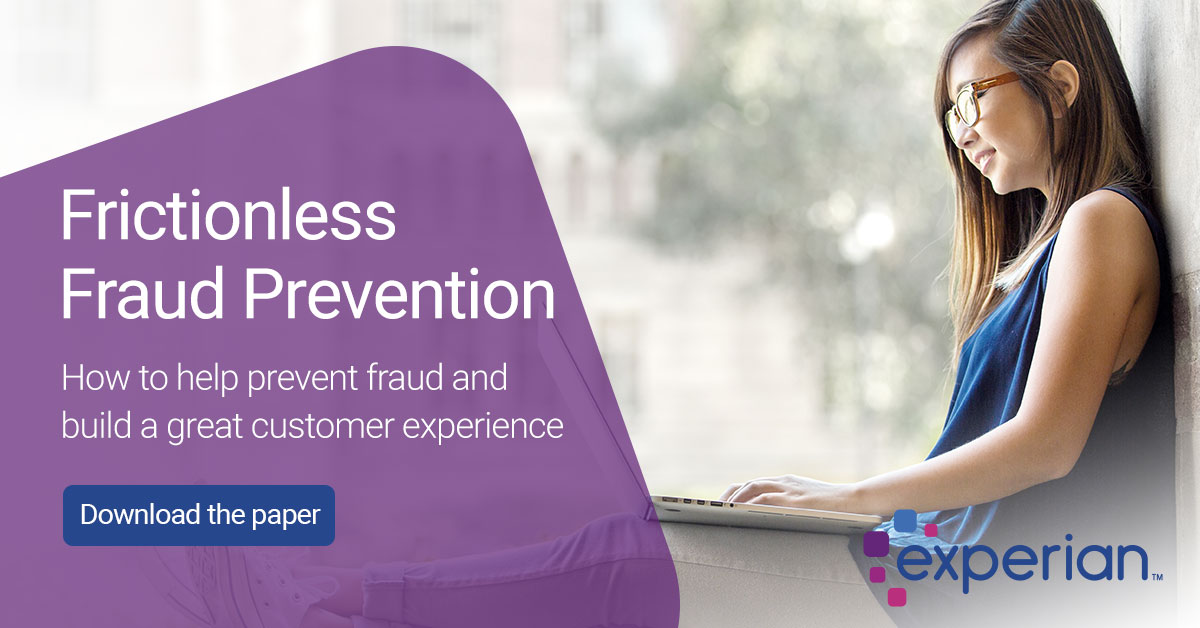To effectively prevent fraud, you need to identify and authenticate customers with a total degree of certainty that they are who they say they are. That’s fine, but if manual checks are required, or if customer data must be cross-referenced with external data sources, the result is a slower and more frustrating customer experience.
This is so much of a problem that up to 35% of potential customers drop out of online applications due to friction, according to Experian research. While a tiny percentage of these will be fraudsters who fail to access a product, most are genuine customers who would do business with you if navigating the security checks wasn’t so hard.
Fortunately for businesses, there are many established and emerging identity, authentication and fraud tools that can help you protect your business and customers – while also taking friction out of your customer journeys. A successful roadmap for frictionless fraud prevention will include several, or all, of the following key technology building blocks:
1. Paperless fraud checks
The onboarding process for high-value services and products, such as mortgages, often requires customers to provide identity documents on paper. Customers have to copy and send their passports, driving licenses, birth certificates, or other documents, and wait while they are physically reviewed by the relevant teams in your business, resulting in slow, frustrating experiences.
To overcome this challenge, consider replacing paper identity documents with electronic equivalents that can be emailed or sent as a photo attachment using applications. This can help you provide faster, slicker, more satisfying experiences for customers and differentiate your brand. One example would be a ‘selfie’ app that allows a customer to identify themselves by taking a photograph of their own face and sending it to their provider who can match it against an ID document – reducing the need for manual security checks.
2. Trusted digital identities
Today, customers may be asked to enter a password or provide their personally identifiable information to log into an online account, or conduct a transaction. This takes time, as well as introducing security vulnerabilities with weak passwords that cybercriminals can breach. Having to remember passwords can also be a pain for customers, with four out of ten needing to use a password memory service to help them remember all their passwords, according to Experian Research.
In the future, trusted digital identities will be a way to overcome the challenges of password-based access. By bringing together all known data about a customer, including their online behaviour and device biometrics, digital identities will enable faster, more trusted authentication, slick customer experiences and greater fraud protection.
3. Integrated, multi-layered fraud systems
Disparate systems and databases make it difficult to identify and authenticate customers quickly. At the same time, they can introduce more friction into customer interactions, especially if customers have to provide their details more than once to different departments, or contact you via different channels.
By breaking down silos internally and integrating systems across your business, you can implement fraud solutions that provide a single customer view. This allows you to identify and authenticate customers with a greater degree of certainty, identify and react to potential fraud faster, and remove friction from your customer journeys with fast, consistent services across all channels.
3. Predictive data modelling
Current fraud solutions may trigger an alert if suspicious activity is detected, but they don’t necessarily help you to understand broader fraud trends or to implement measures that address them.
Using the latest predictive data modelling tools, such as advanced analytics and machine learning, you can identify fraud trends across your customer base. This helps you to identify the root causes of fraud and put effective fraud prevention measures in place. It also helps you understand your customers’ behaviour patterns, needs and preferences, helping you to fine-tune your business strategy and maximise cross and upsell opportunities.
5. New, innovative fraud-detection tools
The latest fraud technologies can help to protect your business and customers while also reducing friction in customer interactions. There are technologies that replace password access with two-factor or biometric authentication to make access easier for customers and increase security. There is also a wide range of tools available for bringing in data from customers’ online journeys, which helps to flag unusual or ‘out-of-character’ behaviour, use of a different or out-of-country device, or other potential fraud indicators.
Experian is an expert in helping companies implement strong, frictionless-fraud prevention strategies based on the best technology building blocks available today. Our CrossCore platform is the industry’s first open fraud and identity platform that integrates all available identity data about a customer with next-generation tools for validation and authentication. CrossCore also has advanced analytics and machine learning capabilities which can help to evolve your fraud strategies as the fraud landscape changes, helping you react to new threats before it costs your businesses and customers.
To find out how we can help you evolve your fraud environment to achieve better results for your business and your customers, view our frictionless fraud prevention white paper here, request a call back here , or visit our identity and fraud solutions and services page.

